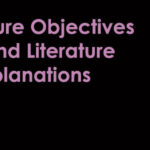Set 6 | Important Languages and Literature of India MCQs
Important Languages and Literature of India MCQs . Indian Languages and Literature are an integral part of Indian Art and Culture, which is extremely beneficial for various examinations such as Civil services, State exams, SSC, Railways, Banking and other One day exams. It provides a great opportunity to gain knowledge about the country’s history in order to excel in these competitive fields. Objectives on Indian Art and Culture for competitive exams.
| MCQs on Languages and Literature of India – Objective Questions and Answers |
Q51. The earliest Buddhist work were written in which language?
[A] Hindi
[B] Sanskrit
[C] Pali
[D] None
View Explanation
Correct Answer is C.
- The earliest Buddhist works were written in Pali, which was spoken in Magadha and South Bihar.
- The Buddhist works can be divided into canonical and the non-canonical.
- The Canonical literature is best represented by the Tipitaka.
- The non-Canonical literature is best represented by the Jatakas.
Q52. The canonical literature in Buddhism is known as?
[A] Jatakas
[B] Tipitaka
[C] Sutta Pitaka
[D] None
View Explanation
Correct Answer is B.
- The Canonical literature is best represented by the Tipitaka(Three Baskets).
- Vinaya Pitaka(Basket of Discipline) – deals with rules and regulations of daily life.
- Sutta Pitaka(Basket of Discourse) – contains dialogues and discourses on morality and deals with Dharma.
- Abhidhamma Pitaka(Basket of Special Doctrine) – deals with philosophy and metaphysics.
Q53. The non-canonical literature of Buddhism is known as?
[A] Abhidhamma Pitaka
[B] Vinay Pitaka
[C] Sutta Pitaka
[D] Jatakas
View Explanation
Correct Answer is D.
- The non-canonical literature is best represented by the Jatakas.
- Jatakas are the most interesting stories on the previous births of the Buddha.
- It was believed that before he was finally born as Gautama, the Buddha practising Dharma passed through more than 550 births, in many cases even in the form of animals.
- Each birth story is called as Jataka.
- The Jatakas throw invaluable light on the social and economic conditions ranging from the 6th century BCE to the 2nd century BCE.
Q54. Which language is majorly used in Jainism?
[A] Prakrit
[B] Pali
[C] Sanskrit
[D] Tamil
View Explanation
Correct Answer is A.
- The Ardhamagadhi(or simply Magadhi) Prakrit was used extensively to write scriptures of Jainism.
- The Jain texts were finally compiled in the 6th century CE in Valabhi in Gujarat.
- The important works are known as Angas, Upangas, Prakirnas, Chheda Sutra and Malasutras.
- Jainism helped in the growth of a rich literature comprising poetry, philosophy and grammer.
Q55. How many Sangamas were held?
[A] 1
[B] 4
[C] 3
[D] 0
View Explanation
Correct Answer is C.
- Three Sangams were held. Poets, bards and writers, authors came from various parts of South India to Madurai. Such assemblies were called “Sangamas”, and the literature produced in these assemblies was called Sangama literature.
| Sangam | Place | Chairman | Kingdom | Books |
| First | Thenmadurai | Agastya | Pandiya | No books |
| Second | Kapatapuram | Tolkappiyar | Pandiya | Tolkappiyam |
| Third | Madurai | Nakkirar | Pandiya | Entire Sanagam Literature |
Q56. Who was the Chairman of the first Sangam?
[A] Nakkirar
[B] Agastya
[C] Patanjali
[D] Tolkappiyar
View Explanation
Correct Answer is B.
- Agastya was the chairman of the first sangam that held in Thenmadurai.
- No books survived that time.
Q57. Place of Organization of third Sangam that was held?
[A] Thenmadurai
[B] Kapatapuram
[C] Dravidian
[D] Madurai
View Explanation
Correct Answer is D.
- Place of organisation of third sangam:- Madurai.
- Chaired by Nakkirar.
- It covers entire corpus of Sangam literature.
Q58. In which Sangam, Book ‘Tolkappiyam’ was seen?
[A] 2
[B] 3
[C] 1
[D] 4
View Explanation
Correct Answer is A.
- In Second sangam, book “Tolkappiyam” was seen.
- Chaired by Tolkappiyar.
Q59.Which one is the oldest extant Tamil grammar book?
[A] Murugarruppadai
[B] Kurunttogai
[C] Tolkappiyam
[D] None
View Explanation
Correct Answer is C.
- Tolkappiyam is the oldest extant Tamil grammar written by Tokkappiyar (one of the 12 disciples of Saint Agastya).
- It is divided into three major parts, each consisting of nine iyals(sub-parts) and has a total of 1612 sutras.
Q60. How many poems are there in Pattupattu?
[A] 8
[B] 10
[C] 11
[D] 7
View Explanation
Correct Answer is B.
- There are 10 poems comprises in Pattupattu.
- Murugarruppadai (by Nakkirar), Sirupanarruppadai (by Nattattanar), Perumbanarruppadai, Maduraikkanji (by Mangudi Marudam), Pattinappalai (by Kannan), and other works, come in this category.
- The poetry in the Pattupattu was divided into two main groups: Aham(deals with matters strictly limited to one aspect of subjective experience) and Puram(deals with matters capable of externalization or objectification).
Related articles:
- Set 1 | Important Languages and Literature of India MCQs
- Set 2 | Important Languages and Literature of India MCQs
- Set 3 | Important Languages and Literature of India MCQs
- Set 4 | Important Languages and Literature of India MCQs
- Set 5 | Important Languages and Literature of India MCQs
- Set 7 | Important Languages and Literature of India MCQs
- Set 8 | Important Languages and Literature of India MCQs


